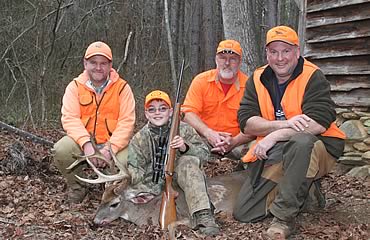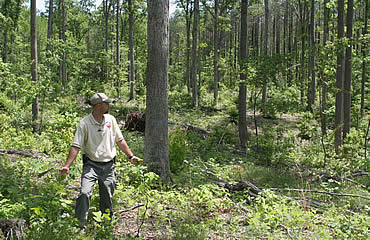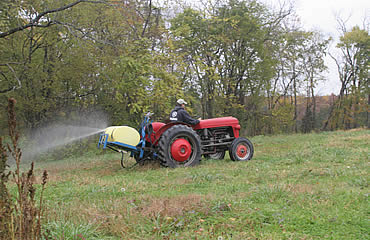There are plenty of reasons QDM works ... and just as many as to why it can fail.
A basket-racked 8-pointer steps into an opening 50 yards from your stand. It’s late in the season and you haven’t tagged a buck. For a fleeting moment, you consider raising your rifle and centering the crosshairs behind the shoulder, but that’s not why you are in the woods. No, you’ve taken plenty of similar deer in the past, and you and your hunting partners are two years into a management plan. Next year, you think, that buck will be a shooter.
Unfortunately, you won’t see that buck next season because you don’t understand the entire concept of quality deer management. QDM isn’t simply a matter of passing up little bucks and hoping they turn into wallhangers in a few seasons. A quality deer management program goes far beyond selective harvest. And that’s just one reason so many hunters don’t succeed at producing a healthier deer herd or bigger bucks.
Acreage Matters
One reason so many hunters’ management efforts fail is that they simply don’t have enough land. Although the recommended minimum acreages vary with habitat, the general rule is in the neighborhood of 1,000 contiguous acres, even more in regions with poor habitat. Why so much? A whitetail’s home range, the area in which it spends the vast majority of its life, can be as much as 500 acres. Bucks that travel across your 200-acre tract also live on your neighbor’s 20, 30 or 50-acre lot, and they live on his neighbor’s land as well. You might have the best intentions of letting a spike or young 8-pointer walk, but if a hunter on the other side of the fence doesn’t, your management efforts have just gone up in a puff of rifle smoke. The larger the tract, the better the odds that buck will stay on your land and live an extra season.
That’s not to say you can’t practice QDM with a small spread. “A lot of landowners who don’t have big tracts are forming cooperatives with adjoining landowners,” said Quality Deer Management Association director of education and outreach Kip Adams. “That’s turned into a highly successful way to manage a whole bunch of smaller properties as a single unit.
“I know a couple of guys who started out with something like 50 acres each, and they managed to convince quite a few hunters around them to form a cooperative. Now they have several thousand acres.”
So what if your neighbors don’t want to take part? There really isn’t much you can do except hope that they’ll eventually realize the benefits of a management program.
 Total Management
Total Management
Adams said many hunters who don’t succeed at improving their deer herd don’t understand that QDM includes more than just passing up small bucks. A successful management program has four primary ingredients: herd management, hunter management, habitat management and herd monitoring.
“It’s like a four-legged chair. Without one leg, the whole thing falls down,” said Adams.
The last is perhaps the most difficult, but it’s just as important as the others. Knowing how many deer are on your property as well as their general health can help you make better decisions. Adams suggested using trail cameras and log books to record deer sightings so you can monitor the buck-to-doe ratio and the overall population. With that information and the advice of your local wildlife biologist, you can determine the level of harvest necessary to have healthier deer.
“All the hunters on the property have to follow the guidelines in order to have a successful program. If a couple of guys in your club refuse to shoot does and still take small bucks, you’ll be facing an uphill battle,” Adams added. “Even if everyone is in complete agreement on the strategy, they still have to take the time to record harvest data like weight and age so you can get a handle on herd health. That’s what we mean by hunter management.”
Habitat management is also more complex than simply dropping some clover or wheat seed on the ground. Deer eat hundreds of different foods, so it’s important to manage your entire property, including the natural forage. Whitetails need a good selection of high-quality forage all year.
“You might need to harvest some timber or even utilize a controlled burn,” Adams said. The use of selective herbicides to kill plants that don’t provide any benefit to deer will also help. If you can, we typically recommend killing off any fescue or other cool-season grasses and planting something in its place that benefits deer.”
There’s no better way to understand a total management plan than with the help of a professional. Adams said his organization has experts who provide technical assistance to members, and most state wildlife agencies gladly offer advice for improving your deer herd. The actual work, however, falls on your shoulders.
 Be Patient
Be Patient
The work can be back-breaking, time-consuming and expensive. Adams said a successful management program can take years, but many hunters start to get frustrated if they aren’t harvesting big bucks in just a couple of seasons. By simply passing up small bucks during the first couple of years, you should see a few larger deer, but don’t expect to see a herd of record-book bucks parading through the woods. It’s easy to get a buck to 2 1/2 years old, but getting that same animal to 4 1/2 is difficult and requires a number of factors to fall into place, including luck.
“If you have too many deer and poor habitat, it will take several years to start realizing the full effect of an intensive management program,” Adams said. “Your ability to manage the herd might also be hampered by harvest limits. Even if you need to take, say, 20 deer off your property, bag limits might only allow you and your friends to take 10. That will slow the process.”
Positive results from habitat improvements can also take several years, especially with activities like selective timber harvests, controlled burns and things that rely on the natural regeneration process.
“Be patient. Stay on top of your plan and follow through with all the necessary steps. Eventually, you’ll see small improvements. Then things will really start to take off if you follow all the basic guidelines — not just one or two.”
 Be Realistic
Be Realistic
Which leads to another common mistake: Too many hunters expect too much of their local deer herd. Even when all the pieces of the puzzle fit perfectly together and your management program is on cruise control, you might never see a monster buck. Why not? Because your definition of a monster is far bigger than your deer are capable of becoming.
That’s not to say you can’t grow bigger deer. Of course you can. That’s one of the primary benefits of practicing deer management. But “big” is a relative term. When Adams was a biologist in Florida, a public-land whitetail that scored more than 100 inches was a big buck. However, he knew of a managed property that surrendered a few bucks in the 130-inch range every couple of seasons. Adams said the hunters couldn’t have been happier, because they knew their deer herd was limited by the habitat.
“Were these guys ever going to shoot a 150-inch buck?” Adams asks. “Unlikely. The habitat and genetics just weren’t there to grow a buck that big. You have to take a realistic look at what your local deer herd is capable of producing. Will a thousand acres in Virginia or Alabama produce the size and number of quality bucks as a thousand acres in Iowa or Illinois? No.”
Don’t Take It Too Seriously
What’s your ultimate goal? Why do you want to practice QDM? Do you simply want to grow bigger bucks, or do you want to improve the land, keep the deer herd in good shape and spend some relaxing hours on your tractor or four-wheeler? Adams said it’s important to take your management efforts seriously, but don’t turn into a dictator, tormented by details that really don’t matter in the long run. Some hunters do just that, insisting that fellow club members or guests follow a stringent set of rules and berating them if they don’t. Shoot this, don’t shoot that, go here, and stay out of there. Isn’t hunting supposed to be fun?
“Would I want a kid shooting a spike if I was practicing QDM?” Adams said “Absolutely. There’s no better way to build a beginning hunter’s confidence and love of hunting than by letting him take a legal deer, even if it falls outside of your management plan. But you certainly don’t want to take eight or 10 small bucks; that would defeat a large part of QDM.”
Taking a small buck or two off a big tract of land won’t ruin your management efforts, and forcing a young boy or girl to pass up a first buck might ruin their taste for hunting. In a few years, the same kid who shot his first spike on your managed land might be your best advocate for creating a healthy deer herd with a few big bucks mixed in.
For more information, visit www.qdma.com
Read Recent Articles: • White Smoke and Winter Whitetails: You can still fill your tag with a late-season blackpowder hunt.
• Rubbin’ Up the Wrong Tree: Not all rubs are created equal. Here’s how to determine which you should pay attention to.
• Lessons Learnt: Following are a few pearls of wisdom from a professional deer manager and hunter.
This article was published in the September 2008 edition of Buckmasters Whitetail Magazine. Join today to have Buckmasters delivered to your home.